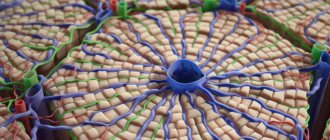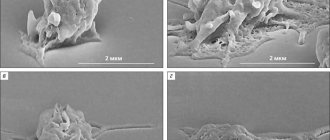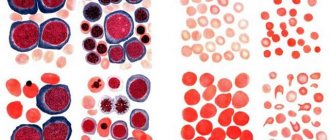Normal blood chlorine content
The indicator of the substance changes according to the age of the person. There is no division depending on gender, since hormonal levels or physiological characteristics do not affect the volume of chlorine. When interpreting the results of a blood test for chlorine, a table is used that shows the upper and lower limits of normal. A result higher or lower than them is a reason for a full examination.
- From birth to 2 months - 97-117 mmol/l.
- From 2 months to 12 months - 94-114 mmol/l.
- From 12 months to 15 years - 95-109 mmol/l.
- From 15 years - 96-106 mmol/l.
To determine the level of a substance in the body, not only blood, but also urine is often examined. This allows you to obtain maximum data about a person’s condition.
Symptoms
So, what does increased chlorine in the blood mean is clear. But by what signs can one determine that the content of a given substance has moved away from the norm? The following symptoms indicate this:
- High blood pressure.
- Irregular heart rhythm.
- Fluid retention.
- Twitching, spasms, muscle weakness.
- Cramps.
- Changes in character.
- Difficulties with concentrating.
- Body tingling or numbness.
How severe the symptoms will be depends on the person's immune system, their diet, and whether they are taking any medications.
The signs of electrolyte imbalance and hyperchloremia are very similar. Therefore, it is difficult to diagnose this syndrome, taking into account only the symptoms. To do this you need to go to the doctor.
What causes chlorine levels to rise?
When blood chlorine is elevated, there may be various reasons for this. All of them are divided into 2 large categories - relative and absolute. Relative causes of increased chlorine include:
- dehydration,
- increased blood viscosity,
- unhealthy diet
- increased thrombus formation.
Fluid deficiency in the body is considered the primary cause of increased chlorides in the blood. Dehydration can develop both due to insufficient water intake and due to the use of diuretics, dysbacteriosis, prolonged intense diarrhea and profuse vomiting. If there is insufficient fluid, the body loses the ability to remove excess substances through sweat or urine and therefore its level, if necessary, cannot be lowered naturally.
It is known that more chlorine is lost with intense and repeated vomiting than with diarrhea. This is how hypochloremia develops.
The absolute reasons that the level of chlorine in the blood is elevated are:
- nephritis,
- nephrosis,
- nephrosclerosis,
- disturbance of metabolic processes,
- metabolic acidosis,
- excessively strong and very frequent breathing,
- disorders in the functioning of the cardiovascular system,
- renal failure,
- Cushing's disease,
- diabetes insipidus,
- acetylsalicylic acid poisoning,
- urethrosigmostomy,
- use of carbanhydrase inhibitors (Diacarb).
The group is called absolute, since in all of the above diseases and conditions, chlorides in the blood are always elevated.
When is there an excess of a substance?
Elevated blood chloride is normal for infants up to 6 weeks of age. In them this figure can reach 116 mmol/l. Then it goes down a little. But still, up to a year of life, the chlorine level varies from 95 to 115 mmol/l.
And this indicator persists for approximately 15 years. After overcoming this age limit, the concentration of the element in the serum approaches the “adult” norm.
How is the analysis carried out?
In order to determine increased or decreased chlorine in the blood, it is taken from a vein on the elbow or the inside of the wrist. The choice is up to the nurse performing the test and depends on the availability of the vein. Blood is taken using a special syringe or thin needle and test tube after antiseptic treatment of the skin in the puncture area. The entire procedure for collecting material takes 2-3 minutes. The collection is carried out on an empty stomach from 8 a.m. to 12 noon.
The resulting blood is centrifuged to separate the plasma. This is necessary in order to obtain blood serum. Chlorine is isolated in the serum using special compounds. Then the amount of chlorides is determined. Based on the results of the analysis, additional examination or treatment may be prescribed if the cause of the pathological disorder in the blood is known.
- Blood cholesterol levels - table by age. Cholesterol in the blood - norms for women, men and children
Chlorine value
Anions of this substance are part of almost all body fluids. Most of them are in the intercellular and blood. The main task of chlorine is to maintain acid-base balance.
It is also part of the gastric juice, which is necessary for the digestion of food. Its acid destroys microorganisms of pathogenic origin and removes them from the body.
Chlorine also helps relieve swelling, stabilize blood pressure, and normal liver function. The serum of a healthy person normally contains an amount of the substance that is obtained at the rate of 30 mmol/kg. In the blood - from 97 to 108 mmol/l.
Foods rich in chlorine
Since chlorine enters the body from the outside, in order not to increase its level to dangerous values, you should not consume foods rich in it in large quantities. These include:
- buckwheat grain,
- rice cereal,
- peas,
- eggs,
- fatty sea fish,
- crucian carp
Also, speaking about how to lower the level of chlorides in the blood through nutrition, it should be noted that table and sea salts retain fluid in the body and prevent the timely release of chlorine, which is why its normal concentration in the body is exceeded. It is especially necessary to monitor nutrition for persons with predisposing factors for high levels of this substance in the blood.
Chlorine
Chlorine (Cl–) is a constant component of plant and animal tissues, present mainly in the form of an ion due to the dissociation of sodium, potassium, calcium, magnesium, etc. salts. Chlorine is the main anion of the extracellular fluid, its concentration in the cell is 3-4 mmol/l, in the intercellular fluid (including in blood plasma) about 100 mmol/l. Chlorine plays an important role in maintaining the core, osmotic balance of blood plasma, lymph, CSF and some tissues, water balance in the body, and is a component of gastric juice. Chlorine ions, along with sodium and potassium, form the membrane potential of cells and activate a number of enzymes. With the loss of chlorides, alkalosis develops; with excess consumption, acidosis develops.
Chlorine ions enter the body with food in the form of sodium chloride and, to a lesser extent, potassium chloride. A regular diet covers the daily requirement of an adult for chlorine. Bread, meat and dairy products are especially rich in chlorine. Absorption of Cl– occurs predominantly in the small intestine, but some of the ions are secreted in the stomach along with hydrogen ions and are reabsorbed in subsequent sections of the gastrointestinal tract. Chlorine is excreted from the body mainly through urine (90%) and sweat (6%). The chlorine content in the body depends on the balance of chlorine intake from food; distribution in tissues and body fluids and excretion in urine.
Manifestations of hypo- and hyperchloremia do not have pronounced specificity. Disorders of chlorine metabolism are secondary to disturbances in the metabolism of sodium, hydrogen, and bicarbonates. A decrease in chlorine causes muscle weakness and muscle twitching, characteristic of sodium metabolism disorders; a sharp decrease in chlorine content in the body can lead to a serious condition, even death. With hyperchloremia, agitation, rapid heartbeat, increased blood pressure, swelling, difficulty breathing, and in severe cases, coma are observed. A general picture of the balance of chlorine in the body can be obtained through a comprehensive examination with determination of the level of chlorides in the blood and urine.
An increase in the chlorine content in the blood occurs when the body is dehydrated, as well as when the excretory function of the kidneys is impaired. The level of chlorine in urine depends mainly on its content in food.
A decrease in the level of chlorine in the blood occurs with excessive sweating, vomiting, respiratory and metabolic acidosis, the use of diuretics, and the appearance of edema. A decrease in chlorine content in the blood is caused by kidney diseases, during which the ability of the tubules to reabsorb is impaired, chronic and acute renal failure, and uncontrolled use of diuretics.
Hypochloremia is caused by a state of acidosis of various origins, accompanied by the transition of chlorine ions from the blood to the tissues. A decrease in the concentration of chlorine in the blood is noted with hyperaldosteronism.
An increase in the level of chlorine in the blood occurs with dehydration, impaired renal excretory function, diabetes insipidus, respiratory alkalosis, and adrenal insufficiency.
Hyperchloremia is divided into absolute, which develops when the excretory function of the kidneys is impaired, and relative, associated with dehydration and blood thickening. The development of relative hyperchloremia is caused by insufficient intake of water into the body, diarrhea, vomiting, loss of fluids and salts from burns.
Hyperchloremia can occur with heart failure, the development of edema, the release of chlorine from tissues caused by various reasons, including alkalosis, as well as with the resorption of edema, exudates and transudates. Ingestion of large amounts of sodium chloride from food can lead to hyperchloremia.
Indications for the study
- Kidney disease;
- diabetes insipidus;
- pathology of the adrenal glands;
- monitoring of CORR disorders.
Features of sample collection and storage:
blood serum without signs of hemolysis. Blood is taken with minimal compression of the vein without muscle load.
Research method:
Determination of the concentration of chloride ions in the blood is currently carried out mainly by the ion-selective method.
Reference interval:
98–107 mmol/l
Increased values
- Excess intake of chlorides from food;
- dehydration;
- prolonged diarrhea associated with metabolic acidosis and loss of sodium bicarbonate;
- kidney diseases (nephrosis, nephritis, nephrosclerosis);
- heart failure;
- endocrine diseases (primary hyperparathyroidism, hyperfunction of the adrenal cortex, diabetes insipidus) treatment with steroids;
- respiratory alkalosis.
Reduced values
- Lack of chloride intake from food;
- extrarenal loss of chlorine (excessive sweating, diarrhea, vomiting);
- kidney diseases with tubular damage;
Daily chloride excretion reflects the function of the kidneys and adrenal glands involved in maintaining water and electrolyte balance. Increased excretion of Cl– in the urine (hyperchloruria) is observed with adrenal insufficiency, depletion of sodium reserves, and chronic nephritis; decreased excretion (hypochloruria) – with the development of edema, fasting, vomiting, increased sweating.
In pathological conditions, hypochloruria is a consequence of the release of increased amounts of chlorine through sweat, vomit, and diarrhea. Hypochloruria, as a rule, accompanies hypochloremia with diarrhea and vomiting of various etiologies, in febrile conditions. The causes of hypochloruria are also called chlorine retention in the body; they distinguish between “dry” chlorine retention (transition of chlorine into tissues) and “wet” (transition of chlorine into extracellular fluid), which is observed in pneumonia, which accompanies cardiovascular failure with the development of edema, inflammatory effusions , formation of edema in kidney diseases, etc.
Indications for the study
- Pathology of the kidneys and adrenal glands;
- control of diuretic treatment.
Research method:
Determination of the concentration of chlorine ions in urine is currently carried out mainly by the ion-selective method.
Reference interval:
110–250 mmol/day
Increased values
- Increased consumption of table salt;
- hyperchloremia of various origins;
- increased diuresis of any origin;
- kidney diseases with tubular damage;
- resorption of edema, exudates and transudates;
- adrenal insufficiency;
- recovery period for infectious diseases;
- depletion of potassium reserves.
Reduced values
- Insufficient consumption of table salt;
- extrarenal loss of chlorides (with sweat, vomit, feces);
- edema of various etiologies (cardiovascular failure, kidney disease);
- hyperfunction of the adrenal cortex and pituitary gland.
Low chlorine levels: causes, symptoms and signs
Pressure surges are not a specific sign of hypochloremia
A person sometimes experiences low levels of chlorine. This condition may also indicate dangerous pathologies. Most often, the cause of this phenomenon is pathologies of the gastrointestinal tract of an inflammatory nature. The complete exact picture of chlorine deficiency in the human body has not yet been determined, but the most characteristic manifestations of the condition are:
- severe exhaustion leading to anorexia;
- insufficient urge to defecate;
- hair loss;
- loss of teeth (in especially severe cases);
- swelling;
- constant pronounced surges in blood pressure;
- alkalosis.
If at least some of the symptoms of the disorder appear, it is necessary to undergo an examination, including identifying the level of chlorine in the blood.
Causes of excess
In other cases, elevated blood chlorine is not normal. If the level of a macroelement does not correspond to standard indicators, which the doctor may suspect even after a general blood test, the patient will need to donate his biomaterial to find out data about its macroelement composition.
The reasons for this phenomenon may be different. Many of them are temporary and therefore do not require drug treatment. But others should be treated promptly.
You should know that increased chlorine in the blood as a phenomenon has a name - hyperchloremia. This diagnosis is made if the level in an adult is more than 108 mmol/l. There are two main reasons:
- Dehydration.
- Metabolic acidosis. This is the name for the shift in the body’s acid-base balance towards acidity.
A change in the amount of chlorine in the blood is fraught with an imbalance in the body's systems, as well as the development of pathological processes.
Dehydration is a danger signal. If a person experiences vomiting, diarrhea, loss of fluid due to burns, or his water regime is simply disturbed, relative hyperchloremia cannot be avoided.
And metabolic acidosis occurs due to the fact that organic acids are not sufficiently oxidized. And, as a result, they are not completely eliminated from the body. This problem is usually indicated by low bicarbonate levels and a corresponding blood pH value.
Diagnostics
As mentioned above, the diagnosis of hyperchloremia almost always requires additional examination. The doctor must understand why this phenomenon occurred. This is necessary to prescribe competent treatment.
What procedures will help determine that chlorine is elevated? Blood analysis. He will also determine whether a person has problems associated with the liver or kidneys.
The patient will also need to provide the doctor with information regarding his diet and list the medications he is taking, even dietary supplements and herbal supplements. Often, it is because of the medications used that the chlorine level changes.
Biological role
The primary “task” of chlorine is to maintain constant osmotic pressure in the blood, lymph, and intracellular fluids, which potentiates the removal of excess waste substances from the body and the distribution of beneficial compounds in tissues, cells and vessels.
Other macronutrient properties:
- participates in the mechanisms of transport of substances into cells;
- improves digestion due to its presence in gastric juice;
- “responsible” for the full functioning of the brain, including the transmission of nerve impulses between neurons;
- potentiates the breakdown of fats;
- regulates the acid-base balance in the body;
- prevents swelling;
- normalizes blood pressure;
- activates amylase;
- improves the functioning of the cardiovascular system;
- protects the body from dehydration;
- maintains normal cell pH levels;
- supports the viability of red blood cells;
- potentiates the removal of carbon dioxide, waste, and toxins from cells and tissues;
- improves the functional state of the liver;
- Helps joint tissue remain flexible and elastic.
Biochemical reactions in the human body in which sodium and potassium ions participate occur only in the presence of chlorine.
Sources of chlorine
A natural source of macronutrients, in addition to chlorinated water, is sodium chloride or regular table salt.
With this product, up to 90% of the daily requirement of the compound enters the human body. In addition, it is present in seafood, grains, animal proteins, vegetables, fruits and greens. Table No. 1 “Natural sources of chlorine”
| Product name | Chlorine content in 100 grams of product, milligrams |
| Table salt | 59 000 |
| Rye bread | 1020 |
| Hard cheese | 880 |
| White bread | 620 |
| Butter | 325 |
| Beef tongue | 250 |
| Pork kidneys | 185 |
| Fish (hake, capelin, pollock, saury, herring) | 170 |
| Oysters | 165 |
| Cottage cheese 9% | 150 |
| Olives | 136 |
| Rice | 133 |
| Cow's milk (whole) 3 – 4% | 115 |
| Kefir (homemade) 3 – 4% | 110 |
| Chicken egg | 105 |
| Pasteurized milk | 100 |
| Oatmeal | 70 |
| Buckwheat | 95 |
| Boiled beets | 60 |
| Peas | 55 |
| Boiled potatoes | 40 |
| Boiled carrots | 35 |
| Cabbage | 30 |
| Apples | 25 |
| Pears | 10 |
Interestingly, adding a pinch of salt to a finished dish increases the concentration of chlorine in food by 3 to 5 times.
Hypernatremia
This, as the name suggests, is the name of a condition in which there is a lot of sodium in the blood. It also occurs frequently.
If sodium is elevated in the blood, and chlorine is also outside the normal range. This element is also responsible for retaining water in the body and maintaining electrolyte balance. It is also involved in the functioning of the muscular and nervous systems.
The normal level of this substance is 135–150 mmol/l in an adult. About 85% of it is found in the blood and lymph.
Physical and chemical properties
Content:
- Physical and chemical properties
- Biological role
- Daily norm
- Insufficiency and excess of chlorine in the body
- Sources of chlorine
- Conclusion
Chlorine is a chemical element of the main subgroup of group VII of the periodic system of D.I. Mendeleev, with atomic number 17. The compound was first isolated in its pure form in 1774 by the German chemist Carl Wilhelm Scheele in Sweden. This element is a chemically active non-metal that is part of the halogen group. Elemental chlorine under normal conditions (0 degrees) is a poisonous gas of yellow-green color with a sharp “suffocating” odor, which is 3 times “heavier” than air.
The compound reacts with almost all chemical elements, forming chlorides (except nitrogen, oxygen, carbon, inert gases). When dissolved in alkalis or water, it dismutates, turning into hypochlorous and hydrochloric acids.
In nature, chlorine is found only in mineral compounds: sylvite KCl, halite NaCl, sylvinite KCl NaCl, carnallite KCl MgCl2 6H2O, bischofite MgCl2 6H2O, kainite KCl MgSO4 3H2O. At the same time, its main reserves are concentrated in salts of sea and ocean waters, the content of which starts from 19 grams per liter.
In a healthy adult body weighing 80 kilograms, there is at least 95 grams of chlorine.
Treatment of hyperchloremia
It is nonspecific, and therefore does not pose any special difficulties. Here's what therapy includes:
- Taking medications to prevent diarrhea, vomiting and nausea.
- Change of medications. This is the case if they are the cause of the imbalance.
- Be sure to drink 3 liters of clean water per day.
- If necessary, obtain intravenous fluids.
- Maintaining a balanced diet.
- Treatment of mental illnesses if they are the cause of digestive disorders.
- Avoid aspirin, coffee and alcohol.
- Monitoring glucose levels.
Normalizing the amount of chlorine in the blood is not difficult. But preventing hyperchloremia is not easy. Especially if it was caused by Addison's disease.
Consequences
If sodium and chlorine are increased in the blood, then the cells lose water, as a result of which their volume decreases. This is fraught with intracerebral hemorrhages. Diarrhea develops, intense sweating begins, and the amount of fluid in the bloodstream increases.
If the amount of cations (sodium in particular) increases to 180 mmol/l, coma, even death, is possible.
If we talk about less terrible consequences, then we should highlight disruption of the renal nephrons and the secretion of vasopressin, high blood pressure, edema (including cerebral edema) and strokes.
That is why you should not ignore symptoms, even those that seem insignificant. The sooner the problem is identified and treatment prescribed, the better.
Daily norm
For healthy people, the daily need for chlorine is 4000 – 6000 milligrams.
With a balanced diet, the compound is supplied in the required amount with food. Today, the upper permissible limit for chlorine consumption has not been established, but the minimum dosage is at least 800 milligrams per day.
For children, the daily need for chlorides varies from 300 to 2300 milligrams, depending on the age of the child.
The daily dosage of a macronutrient is:
- for infants up to 3 months – 300 milligrams;
- for infants 4 – 6 months – 450 milligrams;
- for babies up to one year – 550 milligrams;
- for children from 1 to 3 years – 800 milligrams;
- for preschoolers (5 – 7 years old) – 1100 milligrams;
- for schoolchildren from 7 to 11 years old – 1700 milligrams;
- for adolescents under 14 years old – 1900 milligrams;
- for boys from 14 to 17 years old – 2300 milligrams.
The need for chlorine increases with hot weather, intense sports, increased water consumption, and excessive sweating.











